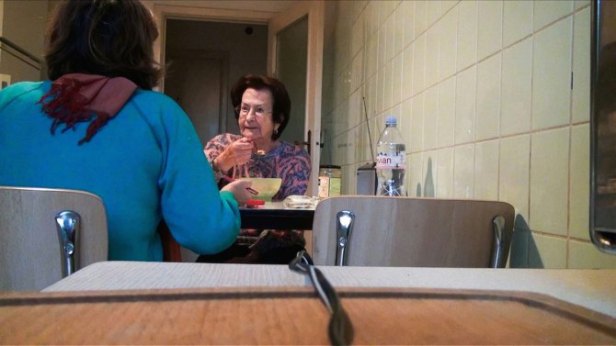
This is a blog written last year (for Women’s Film and Television History Network), on the first screening of Akerman’s last film and its accompanying exhibition. Although the exhibition has finished, I hope this captures an idea of these intense films as the moving and powerful No Home Movie is released in the U.K.
The two-year retrospective of Chantal Akerman’s films, curated by Joanna Hogg and Adam Roberts under the title A Nos Amours, had its last screening on Friday 30th October (2015) at the Regent Street Cinema, with her latest film No Home Movie (2015). Following Akerman’s recent tragic death, there was still a palpable sense of shock, and an appropriately emotional and dignified introduction was given by Akerman’s long-term collaborator and editor, Claire Atherton. She has been in London for the last fortnight helping to curate the NOW exhibition, the first complete showing of some of Akerman’s installation works, which is at Ambika P3, a gallery space at the University of Westminster (exhibited until 6th December 2015). Both the film and Akerman’s installation work are simultaneously revelatory and quintessentially Akerman and demand to be seen. Below, are some brief, first impressions.
The large, light space has been converted into something very subterranean and dark to suit the films’ projection and their emotion. In a mixture of single films, often with an audio commentary, and multi-screen installations, there is no single dimension, and the choices made in this report are idiosyncratic ones. In a piece entitled Maniac Summer (2009), a large-screen projects images including Akerman working in her flat, families playing outside in a park and a street scene. Along a perpendicular wall, the images appear to dissolve and deteriorate, turn to black and white, and, on the facing wall, coalesce into abstraction. Staying within that room over an extended period brings a shift in perception of time and space and a move beyond observing simple juxtapositions, and, in a very Akerman-like manner, the sheer intensity (if given time) breaks through to something much more experiential. The accompanying notes suggest this work fits with her commitment to exploring the legacy of the Holocaust: “looking for, and finding, traces, shadows, remnants” since, given the continent’s recent history: “what else should a European be sensible of?”. Her mother grew up in Poland and was imprisoned in Auschwitz, and in the work D’Est: au bord de la fiction (1995), a room is filled with rows of televisions, divided into groups of three, showing footage from Akerman’s journey across Eastern Europe. The filmmaker voices a poetic monologue in an accompanying video, about a journey through a history that no longer has a capital H.
The daughter’s relationship with the mother is everywhere in this exhibition as it is in No Home Movie (2015). During Maniac Shadows (2013), their outlines move across the beach – together and apart. Elsewhere, Akerman on screen, with the merest backlight highlighting her figure, reads from a memoir about her mother’s failing health. Her trademark warm, throaty, strongly-accented voice (pervading the whole exhibition) contributes to this piece’s emotion. And, as Akerman’s work has been concerned with many forms of grief, so this exhibition itself has become a site of loss, vividly representing her simultaneous presence and her absence.
Akerman’s mother passed away last year, and she is the central figure of No Home Movie, which also includes Akerman’s sister, Sylviane (who attended both the screening and the exhibition). Scenes capture aspects of family life with their ailing mother in her Belgian flat very realistically, with flashes of extremely relatable family tension between them. Abstract sequences from Akerman’s filmmaking travels punctuate the motionless camera witnessing daily rhythms inside the flat. Maman moves in and out of shot as does Akerman and also the home helpers; we watch the domestic routine – of course, this reminds us of Jeanne Dielman 23 quai du Commerce, 1080 Bruxelles (1975) but there are also echoes, here, of the relationship of News from Home (1976-7). We hear her mother’s rhythmic throat noise, an effect of old age but musical, comforting and quickly familiar. Akerman commands a multiplicity of tones: abstract, intimate, contemplative and dryly humorous. As J Hoberman says in a quote at Ambika P3, “Comparable in force and originality to Godard or Fassbinder, Chantal Akerman is arguably the most important European director of her generation”. I would like to finish with another stolen phrase from a young woman who sat next to me and cried many times during the film. She said it had shown her the dignity of being human. If only Akerman had been there, as planned, to hear the comments and sustained applause that greeted the final credits.
